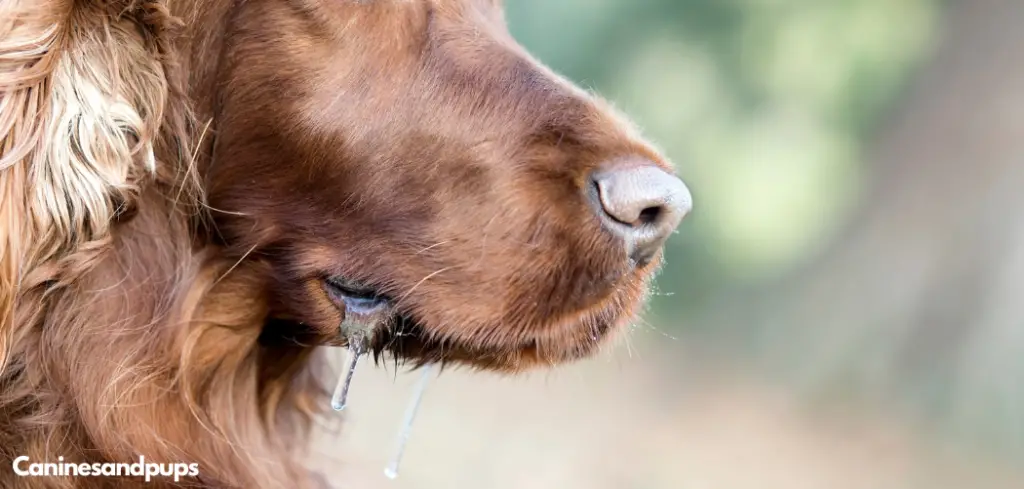It can be confusing and even alarming to see your dog drooling more than usual, especially if there are no other obvious symptoms.
While drooling is normal in some breeds, excessive or sudden drooling may point to underlying issues that need attention.
We outline the common causes of dog drooling with no other symptoms, what you can do at home, and when to seek veterinary help.
Dog Drooling No Other Symptoms — Why It Happens
A dog that drools without showing other signs of illness can still be experiencing an underlying problem. Excessive saliva can result from dental disease, nausea, anxiety, or simply breed tendencies. Sometimes, it’s triggered by excitement or the anticipation of food. In other cases, drooling may be an early sign of oral pain or toxins.
The absence of additional symptoms doesn’t always mean it’s harmless, so it’s important to pay attention to patterns and duration.

Dog Drooling No Other Symptoms: Common Causes
Dental Disease
One of the most frequent reasons for drooling is dental or gum disease. Plaque and tartar buildup can irritate the gums, leading to discomfort and extra saliva production.
Dogs with infected teeth or sore gums may drool even if they otherwise seem fine. If left untreated, this can progress to painful abscesses and tooth loss.
Read more: Dog drooling and not eating (What it means for your pup)
Breed Characteristics
Certain breeds are simply prone to drooling because of their anatomy. Dogs with loose lips and jowls, such as Saint Bernards, Mastiffs, and Bloodhounds, naturally produce more saliva.
This type of drooling isn’t linked to illness and usually isn’t accompanied by other symptoms.
If your dog belongs to one of these breeds, drooling may just be part of their normal behavior.
Nausea or Motion Sickness
Even if your dog isn’t actively vomiting, drooling can signal nausea. Some dogs drool heavily during car rides or when their stomach is unsettled.
You may not notice other symptoms right away, but the saliva buildup is their body’s response to discomfort. This type of drooling often comes and goes depending on the situation.
Anxiety or Excitement
Dogs experiencing stress, fear, or even high levels of excitement may start to drool. For example, a trip to the vet, loud noises, or the anticipation of a meal can all trigger excess saliva.
This type of drooling typically resolves once the emotional trigger passes. While not usually harmful, it’s helpful to observe what situations cause your dog to drool more.
Foreign Object in the Mouth
Sometimes, drooling occurs because something small is stuck in your dog’s teeth, gums, or palate.
A piece of food, a stick, or even a small toy can irritate the mouth without immediately causing pain or other symptoms.
If your dog is drooling suddenly, it’s worth checking their mouth carefully for any lodged objects.
Exposure to Toxins or Irritants
Certain plants, chemicals, or household substances can cause drooling when licked or chewed.
While poisoning often comes with additional symptoms, some mild exposures may begin with drooling alone.
For example, licking a cleaning solution or chewing on an irritating plant could trigger excess saliva. If you suspect toxin exposure, veterinary advice is essential.
What to Do If Your Dog Is Drooling With No Other Symptoms
If your dog’s drooling seems unusual, first consider their breed and recent activity. A drooly Saint Bernard after mealtime may not be a cause for worry, while a normally dry-mouthed dog suddenly salivating might need closer attention.
Check their mouth for stuck objects, gum inflammation, or signs of dental disease. If you recently used cleaning products, check that your dog didn’t lick or chew anything unsafe.
At home, you can wipe away saliva to keep them comfortable and ensure they have access to clean, fresh water. If drooling happens during car rides, try shorter trips, allow your dog to face forward, and ask your vet about motion sickness options.
If anxiety triggers drooling, offering reassurance, a calm environment, or gradual desensitization to triggers may help.
When to Call or Visit Your Vet
If drooling continues for more than a day without an obvious cause, it’s wise to consult your veterinarian. Persistent drooling may be an early warning sign of dental disease or another hidden issue.
Seek immediate veterinary care if drooling is accompanied by pawing at the mouth, difficulty swallowing, vomiting, weakness, or changes in behavior. These can point to poisoning, heatstroke, or serious oral problems.
Even if drooling is the only symptom, a sudden change in your dog’s behavior or comfort level should not be ignored. Early intervention can prevent more serious complications.
Read more: Dog Coughing No Other Symptoms (When it’s harmless and when it’s not)
Key Takeaway
Dog drooling with no other symptoms may seem harmless, but it can sometimes indicate an early-stage problem.
Dental issues, breed traits, anxiety, nausea, or exposure to irritants are all possible causes. Monitor your dog closely, check for visible oral issues, and don’t hesitate to contact your vet if the drooling persists or if you feel uneasy.
Being proactive helps ensure your dog stays healthy and comfortable, giving you peace of mind that you’re taking the best care of them.
